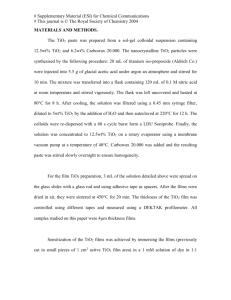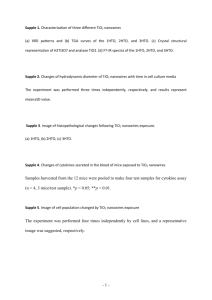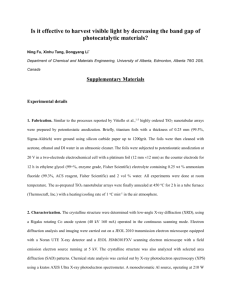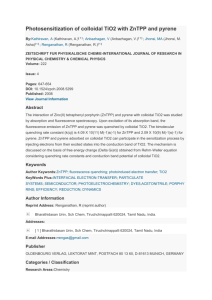L11-10914RFIX_Supplementary Information
advertisement
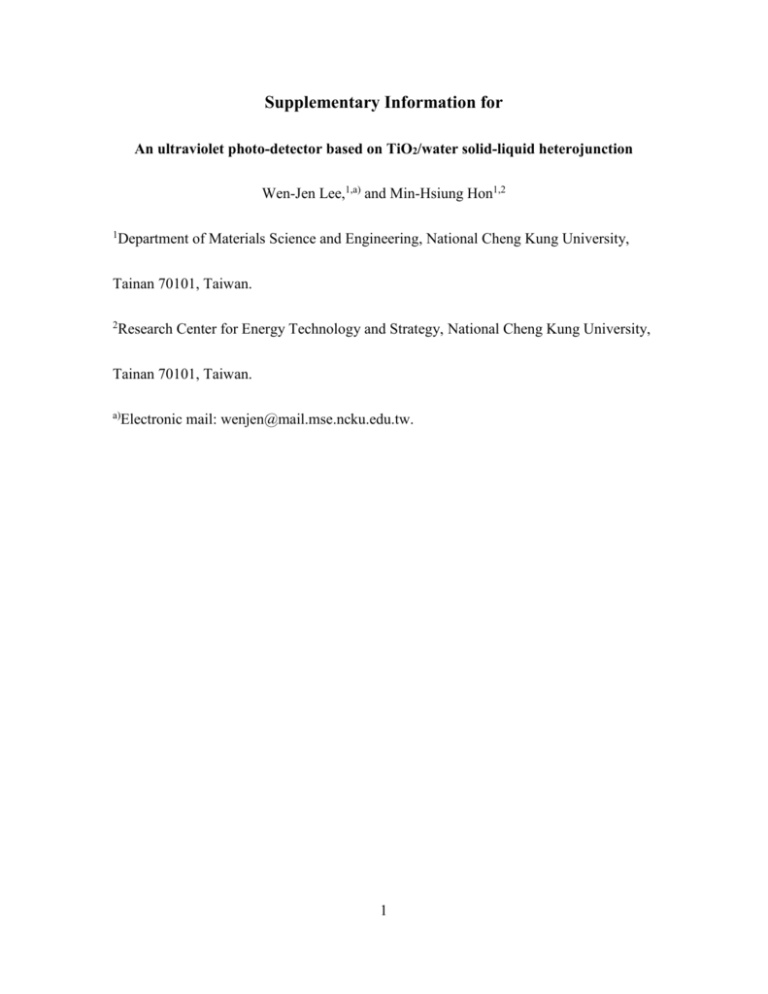
Supplementary Information for An ultraviolet photo-detector based on TiO2/water solid-liquid heterojunction Wen-Jen Lee,1,a) and Min-Hsiung Hon1,2 1 Department of Materials Science and Engineering, National Cheng Kung University, Tainan 70101, Taiwan. 2 Research Center for Energy Technology and Strategy, National Cheng Kung University, Tainan 70101, Taiwan. a) Electronic mail: wenjen@mail.mse.ncku.edu.tw. 1 Information of Commercial UV-detectors The related data of commercial SiC, AlGaN, and TiO2 SSJ UV-PDs (cited in this paper) are obtained from the website of sglux GmbH. The product datasheets for SiC, AlGaN, and TiO2 UV photodiodes are available in the website of sglux GmbH (http://www.sglux.de/Products.2.0.html?&L=1). 2 Supplementary video legends File name: Supplementary Video.mpg Full length: 1 min 59 sec. Video contents: 1. First part (time 00:00:00 to 00:00:35): water electrolyte is poured into the device. 2. 2nd part (time 00:00:35 to 00:01:10): the device is tested using a simple multimeter without any external bias that shows the device no response to visible light (white LED) but does have a response to UV-light (365nm LED, Nichia NSHU591B). 3. 3rd part (00:01:10 to 00:01:59): a demo for the practical application of SLHJ UV-PD (detecting UV-light and driving a buzzer) that shows the device no response to visible light (white LED) but does have a response to UV-light. Additionally, the sound of the buzzer varies with incident UV-light intensity exposed into the SLHJ UV-PD, and the device shows fast response time. UV-LED information: Manufacturer: Nichia corporation (Japan), Model: NSHU591B, Peak wavelength 365 nm, (http://www.nichia.co.jp/specification/en/product/led/NSHU591B-E.pdf). 3 Current-voltage (I-V) characteristics of SLHJ UV-PD with 1 M KOH aqueous electrolyte Figure S-1. Incident light dependent current-voltage (I-V) characteristics of the SLHJ UV-PD (with 1 M KOH aqueous electrolytes) are measured at applied bias from -1 to 1 V and exposed to 365 nm UV-light irradiation with light intensities varying from 22.2 to 479 μW (0.113 to 2.440 mW/cm2). This shows that not only the overall photocurrent has increased but also its photovoltaic property has been enhanced. 4 SLHJ UV-PD response time (a) (b) (c) (d) Figure S-2 Incident light dependent current-time (I-T) characteristics of the SLHJ-PD are measured at 0 V bias and exposed to 365 nm UV-light on/off switching irradiation with a light intensity of (a) 48 nW (0.244 μW/cm2), (c) 22.2 μW (0.113 mW/cm2). (b) and (d) are the enlarged portions of 238 – 242 s and 298 – 302 s ranges obtained from (a) and (c), respectively. The figures show that both decaying and rising times for the SLHJ UV-PD are less than 0.5 s. (limited by the sampling rate of our equipment). 5 Identifying the crystal phase of TiO2 active layer coated on FTO-glass Figure S-3 X-ray diffraction patterns for (a) FTO-glass substrate, and (b) TiO2 active layer coated on FTO-glass by ALD at 450 oC. TiO2 active layer exhibits a rutile crystalline structure. 6 Probable reactions in a water based photoelectrochemical process Figure S-4 Schematic diagram for probable reactions in a water based photoelectrochemical process.→ Reaction I: S1 TiO2 + 2 hv → 2 e- + 2 h+ (excitation of TiO2 by UV-light) 2 h+ + H2O → 1/2 O2 + 2 H+ 2 e- + 2 H+ → H2 (at the TiO2 electrode) (at Pt electrode) Reaction II: 2 H2 O H3O+ + OH- TiO2 + hv → e- + h+ (water self-ionization) (excitation of TiO2 by UV-light) h+ + OH- → OH· (at the TiO2/water interface) e- + OH· → OH- (at Pt/water interface) 7 Reaction I is used to describe the photoelectrochemical reaction of water-splitting by a semiconductor photocatalyst that was proposed by Fujishima et al.S1 and has been widely cited. However, Reaction II (used in this work) is also a probable reaction in a water based photoelectrochemical process that should be carefully considered due to the fact that Reactions I and II are competing. In addition, Reaction II only involves charge transfers, so no moleculular structure has been changed. Therefore, Reaction II may obtain more priority in the photoelectrochemical process than does Reaction I, especially in the absence of external bias conditions. However, we do not deny the likelihood of Reaction I, but no gas generation is observed in this study. Supplementary Reference: (S1) A. Fujishima, K. Honda, Nature 238, 37 (1972). 8 Supplementary experimental methods Experimental details for spectral response and photocurrent measurements of the SLHJ UV-PD. The current-voltage (I-V) and current-time (I-T) characteristics of the SLHJ UV-PD are measured at room temperature using a potentiostat (Autolab PGSTAT12), and a 365 nm UV-LED (Nichia NSHU591B) is used as a light source. Spectral responsivity of the SLHJ UV-PD is measured using a spectrometer (Horiba Jobin Yvon Triax-320) equipped with a tungsten lamp, and an automatic monochromator is used as the wavelength-adjustable light source. The output power of the monochromatic light is measured by a power meter (Ophir NOVA II). 9




